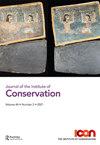Building a material record of Singaporean art through technical art history: a case study of the paintings of Cheong Soo Pieng
IF 0.5
0 HUMANITIES, MULTIDISCIPLINARY
引用次数: 1
Abstract
Abstract With a greater awareness of the importance of context-driven research, there has been an emergence of technical art history studies of works of art from Southeast Asia. This article begins with an overview of the conservation research landscape in Singapore and discusses some of the key challenges which need to be overcome, such as a lack of a robust artist materials dataset and limited local resources for technical examination. Using a structured data collection methodology, data generated from various primary examination techniques were analysed cross-comparatively and the article presents a case study of the investigation of 59 works of art by a pioneering Singaporean artist, Cheong Soo Pieng (1917–1983). Patterns and trends from the study offer insights into the artist’s practice, including an incorporation of local materials marouflaged into traditional canvas preparation techniques. The findings report on the assimilation of art practices and localisation of Western art influences in Soo Pieng’s work, whilst demonstrating that art practices in Southeast Asia are not necessarily a product of Western colonisation. Understanding the artist’s materials and techniques enables the expansion of material knowledge and can serve as an anchor for future study of works of art between the 1940s and 1980s.通过技术艺术史建立新加坡艺术的实物记录:以张素平的绘画为例
随着人们越来越意识到语境驱动研究的重要性,出现了对东南亚艺术作品的技术艺术史研究。本文首先概述了新加坡的保护研究概况,并讨论了需要克服的一些关键挑战,例如缺乏强大的艺术家材料数据集和有限的本地技术检查资源。使用结构化的数据收集方法,从各种主要检查技术产生的数据进行交叉比较分析,文章提出了一个案例研究,由新加坡艺术家郑秀平(1917-1983)的59件艺术作品的调查。研究的模式和趋势为艺术家的实践提供了见解,包括将当地材料融入传统的画布准备技术。研究结果报告了艺术实践的同化和西方艺术影响在素屏作品中的本土化,同时表明东南亚的艺术实践不一定是西方殖民的产物。了解艺术家的材料和技术可以扩展材料知识,并可以作为未来研究20世纪40年代至80年代艺术作品的锚。
本文章由计算机程序翻译,如有差异,请以英文原文为准。
求助全文
约1分钟内获得全文
求助全文
来源期刊

Journal of the Institute of Conservation
HUMANITIES, MULTIDISCIPLINARY-
CiteScore
1.50
自引率
0.00%
发文量
22
期刊介绍:
The Journal of the Institute of Conservation is the peer reviewed publication of the Institute of Conservation (Icon). As such, its aims reflect those of Icon, to advance knowledge and education in conservation and achieve the long term preservation and conservation of moveable and immoveable cultural heritage. The Journal provides a collective identity for conservators; it promotes and supports both the profession and professionalism. With international contributions on all aspects of conservation, it is an invaluable resource for the heritage sector. The specific aims of the Journal are to: 1. promote research, knowledge and understanding of cultural heritage conservation through its history, practice and theory 2. provide an international forum to enable and disseminate advances in research, knowledge and understanding relating to conservation and heritage 3. champion and support professional standards of heritage conservation in the UK and internationally 4. provide a permanent record of issues relating to conservation and heritage 5. be financially and operationally sustainable. To achieve these aims, the Journal invites contributions from all those involved in the conservation of cultural heritage and related activities. Areas of interest include understanding cultural heritage materials and their degradation; subject reviews and histories of cultural heritage materials and conservation treatments; new, innovative or improved approaches to conservation and collections care theory, practice, communication, management and training; case studies demonstrating new, innovative or improved approaches; and conservation in its wider context. Submitters are encouraged to demonstrate how their work is of practical application to conservation. To maintain professional standards and promote academic rigour, submissions of articles and shorter notices are subject to an anonymous peer review process.
 求助内容:
求助内容: 应助结果提醒方式:
应助结果提醒方式:


